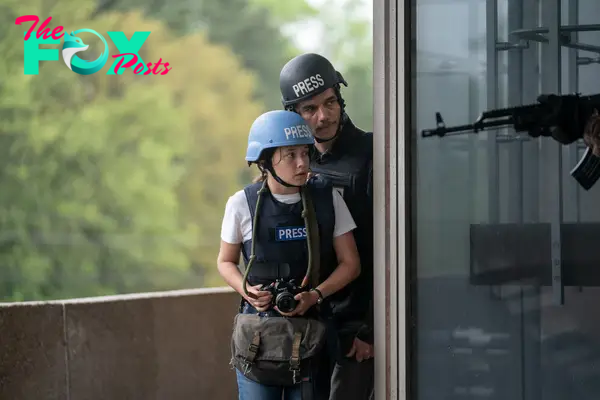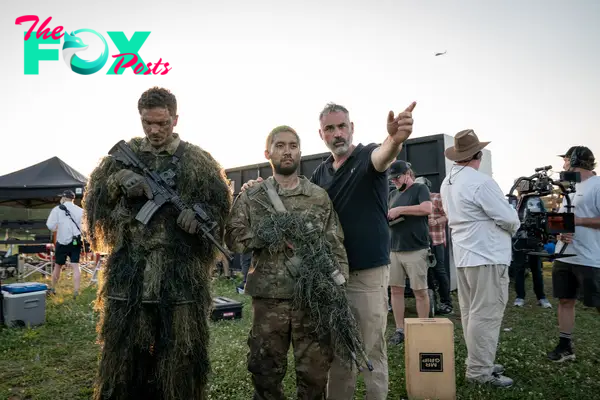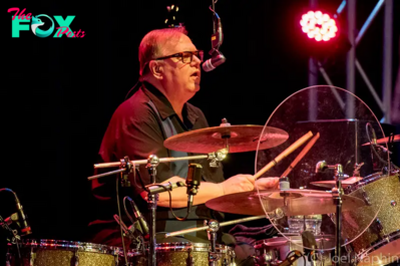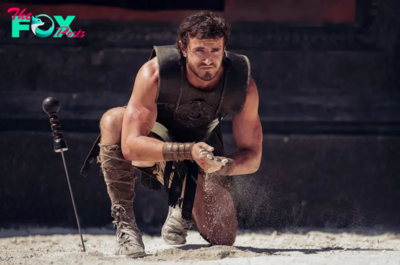Entertainment
How Alex Garland and His Cast Created the Sobering Dystopia of Civil War
Outside of Atlanta, a creaky white van weaved down a highway lined with abandoned cars. A helicopter sat in the parking lot of a charred JCPenney. Armed guards in military fatigues patrolled checkpoints. A death squad dumped corpses into a mass grave. Artillery boomed in the offing.
It was all part of a movie set, but to the actors starring in Civil War, felt all too real. The new film, opening in theaters April 12, takes place in a near-future United States ravaged by coNFLict. California and Texas, which make up the so-called Western Forces, have seceded from the union in response to an authoritarian third-term President who has jettisoned the Constitution, disbanded the FBI, authorized airstrikes on his own citizens, and now aims to “eliminate the final pockets of resistance.” To create as credible a dystopia as possible, director Alex Garland and the crew turned parts of the Atlanta region into a soberingly plausible hot spot.
“It felt very disturbing,” says Kirsten Dunst, one of the leads, of the film’s blurring with reality. “Toward the end, it was all the noise and the gunfire, and then just looking at the news and seeing that there’s another school shooting.”
By the time Civil War premiered at the South by Southwest Film & TV Festival in mid-March, it had already generated some heat online. Reddit commenters debated whether invoking such severe domestic turbulence is irresponsible at a time when the nation’s political divisions have reached a fever pitch. One person worried it “might be interpreted as a role model to MAGA groups if not portrayed carefully.” Garland, the British science-fiction ace who made Ex Machina and Annihilation, anticipated polarized reactions. In a sense, they’re why he made Civil War in the first place. “It’s really a film about why polarization is not a great thing,” he says. “It’s trying to have a conversation. It’s trying to find common ground.”

On top of everything else, Civil War is also an intimate character study. Dunst plays Lee, a jaded photojournalist Traveling with three colleagues—two reporters (Wagner Moura of Narcos fame and Lady Bird’s Stephen McKinley Henderson) and a novice photographer (Priscilla’s Cailee Spaeny)—from New York City to Washington, D.C., which Moura’s grizzled ringleader predicts is on the cusp of falling. There, they hope to question a President (Nick Offerman) who hasn’t given an interview in more than a year. The journey through a nation at war with itself is a circuitous, 857-mile odyssey, much like a video Game in which the hero must evade death or capture by antagonists. In this case, those foes are power-hungry goons wielding carbines. Garland based these threats and detours (which, if you’re doing math, nearly quadrupled the length of the journey) on real-world analogues, like a thug, played by Jesse Plemons, whose MO is loosely inspired by the Khmer Rouge, the totalitarian movement that took over Cambodia in 1975.
Budgeted at $50 million, Civil War is the most expensive movie A24 has released, teeing up a more commercial era for the trendy indie studio that built its renown on auteur-driven projects like The Zone of Interest, Everything Everywhere All at Once, and Moonlight. But unlike some sweeping apocalyptic blockbuster or The Last of Us–style genre hybrid, its psychodrama doesn’t incorporate fantasy tropes. You won’t find any zombies here. Lee becomes a reluctant mentor to Spaeny’s Jessie, who quickly notes that she shares a name with distinguished World War II photojournalist Lee Miller (soon to be portrayed by Kate Winslet in a biopic).
Garland drafted the film during 2020’s COVID-19 lockdowns. He’d contracted the disease early on. Upon emerging from quarantine in Gloucestershire, England, he stepped into what he calls a “reverse Narnia.” The world around him felt strange, paranoid, and divided. He wrote the script that spring, anticipating a future further riven by sectarian strife. He mapped out a fictional backstory to the film’s events but omits most of it from the screen. The year Civil War takes place is unspecified, and although the President seems to have a Trumpian view of the Constitution’s impermanence, there is no firm left-vs.-right ideology at play. Even the actors say they weren’t given much context. “We kind of built what happened before in our own minds,” Moura recalls. “We never really spoke about it.” Even though Civil War forgoes Garland’s usual sci-fi lens, it shares with his previous work a sense that life has spiraled beyond our control. Withholding the how and why is kind of the Garland way.
De-emphasizing the political ticktock lets Civil War home in on its coNFLict’s human toll. As the quartet gets closer to D.C., their steely exteriors crack—and yet their pursuit remains steadfast, even if it could result in death. It’s a higher calling, and perhaps an adrenaline addiction. Garland made the arduous choice to shoot the movie chronologically, so the intensity the actors experienced was constantly mounting. “I’ve never been scared like that before, and I’ve never felt more alive,” Jessie declares after an especially harrowing chapter.
Garland’s crew bolted eight small cameras to the protagonists’ van. Because so many scenes occurred in the car, the production felt profoundly intimate. Spaeny likens the road scenes to a play. But unlike theater, or even a typical movie shoot, Civil War changed locations every few days as the characters’ trek progressed, introducing constant logistical puzzles for the producers and craftspeople to solve.
The third act, filmed at Tyler Perry’s 330-acre Atlanta studio, which contains a replica of the White House, is explosive—literally. Choppers drop bombs, buildings catch fire, Humvees roll in, smoke clogs the night sky. Garland used visual effects to blow up the Lincoln Memorial as the journalists face guerrillas closing in on the capital. To prepare, the cast watched the 2018 documentary Under the Wire, which chronicles war correspondents in Syria. Dunst and Spaeny trained with photographers to master camera functions so they’d seem seasoned even as chaos erupted. “That was my biggest fear: not looking comfortable or like this is something that’s a part of my body,” says Dunst, who studied under Austin-based shutterbug Greg Giannukos. Garland also enlisted Ray Mendoza, a former Navy SEAL, as a military adviser; Mendoza choreographed the final sequence and hired veterans as extras.

The movie’s verisimilitude is what got the internet commentariat buzzing when Civil War’s trailer debuted in December. Some, upon learning the coNFLict’s origins aren’t more explicit, might accuse the movie of pulling punches. But Garland sought to avoid a “lecture” about the state of the nation. “If you’re honest, you don’t need to be told because you already know,” at least vaguely, what caused the turmoil, he says. “There’s a lot of films that tell everything to everyone and make everything completely digestible. I’m not particularly interested in doing it because it feels oppositional to engagement. ‘Left vs. right’ closes down the conversation. That is the problem with polarization.”
Even the idea that Texas and California, which rarely agree on anything, would both secede is a rebuttal to the disunity that Civil War critiques. Why, Garland asks, is it so hard to believe that two disparate states would rebel against a fascist government remaking America in the President’s image? Secession movements in both Texas (dubbed “Texit”) and California (“CalExit”) have sprung up recently, with the latter conceptualizing an “alternative to potential civil violence and civil war in the country.”
If the movie preaches anything, it’s a pacifist gospel. Hollywood sometimes struggles to separate the repugnance of war from the glorification of it. Here, the thesis is unmistakable. “It’s an antiwar film, which is problematic to do because cinema doesn’t necessarily want to be antiwar,” Garland says, reflecting a not-uncommon concern among pundits that the thrill of seeing warfare on a big screen numbs audiences. But from where Garland sits, at least, it demands to be seen. As the subhead on Rolling Stone’s SXSW review blared, "No, it’s not a documentary—yet."
-

 Entertainment1h ago
Entertainment1h agoAmerica On CoffeeWe’re simply inviting you to take a timeout into the rhythmic ambiance of our breakfast, brunch and/or espresso alternatives. We’re comfortable everytime you cease by.Shoe Shoe Shine – The Dynamic Superiors
-

 Entertainment7h ago
Entertainment7h ago3 Completely different Kinds of TV Appearing Roles
-

 Entertainment7h ago
Entertainment7h agoAmerica On CoffeeWe’re simply inviting you to take a timeout into the rhythmic ambiance of our breakfast, brunch and/or espresso alternatives. We’re comfortable everytime you cease by.SYRUPING UP YOUR VERY OWN COFFEE FLAVORS
-

 Entertainment7h ago
Entertainment7h agoMeet Ava, the Golden Tiger Cub in Thailand Set to Be the Next Cute Viral Sensation
-

 Entertainment7h ago
Entertainment7h agoBest Tom Hardy Movies that Are Must-Watch
-

 Entertainment12h ago
Entertainment12h agoThe Smithereens with John Hampson – West Herr Riviera Theatre – North Tonawanda, NY – November 20, 2024
-

 Entertainment18h ago
Entertainment18h agoAmerica On CoffeeWe’re simply inviting you to take a timeout into the rhythmic ambiance of our breakfast, brunch and/or espresso alternatives. We’re comfortable everytime you cease by.Vacation Espresso Cocktail
-

 Entertainment18h ago
Entertainment18h ago12 Methods to Command a Stage
















